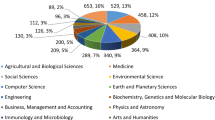Abstract
The Novosibirsk region is one of the most industrialized in Siberia. In 1957 the Siberian Branch of the Academy of Sciences of the USSR (now Siberian Branch of the RAS (SBRAS)) was set up to stimulate a rapid development of the Siberian and Far East research forces. The goal of this mainly bibliometric, empirical study is to obtain insight into R&D performance in the Novosibirsk region, domestic and international collaborations and the impact of new government science policies focused on boosting the research and innovation activities of regional universities. Key drivers of research performance are institutions of the SBRAS. Second place in terms of research output belongs to Novosibirsk State University. Its research focuses on hard sciences. 75% of its papers were published in collaboration with SBRAS institutions. Research output is growing. Novosibirsk area’s share of RFBR grants was stable around 8%. Publications from RFBR grantees in 34 subject categories had a level-aggregated indicator value of one or higher. In these hard-science areas Russian research develops in accordance with global trends. We observed a concentration of domestic collaboration in the Novosibirsk area as well as a strong international collaboration with advanced economies, in particular in the Asia–Pacific region.



Similar content being viewed by others
Notes
ISI is now Thomson Scientific.
LCS—Local citation score shows the count of citations to a paper within the collection; GCS—global citation score shows the total number of citations to a paper in the web of science; T*—total (score) any total score represents a sum of respective scores for all records from a given author, source, other category, or all records. e.g. TLCS—total local citation scores (Glossary, InCites).
References
Garfield, E., & Welljams-Doroff, A. (1990). The language use in international research: a citation analysis. Essays of an Information Scientist, 13, 282–295.
Libkind, I., Markusova, V., Minin, V., & Jansz, M. (2006). Index of RFBR as scientific information search and analysis tool. In The 9th international conference on science and technology indicators, Leuven, Belgium (pp. 229–233).
Markusova, V., Jansz, M., & Libkind, A. (2010). Bibliometric indicators and their impact on Russian university ranking. In Book of abstracts, eleven international conference on science and technology indicators “creating value for users”, Leiden, The Netherlands (pp. 187–188).
Markusova, V., Jansz, M., Libkind, A., Libkind, I., & Varshavsky, A. (2009). Trends in Russian research output in post-soviet era. Scientometrics, 64, 249–260.
Markusova, V. A., Libkind, A. N., Varshavsly, A. E., & Jansz, C. N. M. (2011). Research Performance and collaboration in the Novosibirsk region. In Noyons, E. Ngulube, P. Leta J. (Eds.) Proceedings of ISSI —The 13th international conference on scientometrics and informetrics, Durban, South Africa, 4–7 Jul 2011 (pp. 534–545).
Okubo, Y., Gusmao, R., Sigogneau, A. & Zitt, M. (2000). Measuring impact of trans-frontier regions in Europeanization of science. In Book of abstracts, sixth international conference on science and technology indicators, Leiden, The Netherlands (p. 88).
Pudovkin, A. (2011). Where are Russian researchers published and how are they cited? Troitsky Variant, N76–77, 6–7.
Russian regions. Socio-economics indicators (2009). Moscow, ROSSTAT (990 p.).
Schiermeier, Q. (2010). Russia boosts university science. Nature, 464(7293), 1257.
Wilson, C., & Markusova, V. A. (2004). Changes in the scientific output of Russia from 1980 to 2000, as reflected in the science citation index, in relation to national politico-economic factors. Scientometrics, 59, 345–389.
Acknowledgments
The authors wish to express their gratitude to the anonymous reviewers for their useful comments and suggestions. This article is an extended version of a paper presented at the 13th International Conference on Scientometrics and Informetrics, Durban (South Africa), 4–7 July 2011 (Markusova et al. 2011).
Author information
Authors and Affiliations
Corresponding author
Rights and permissions
About this article
Cite this article
Markusova, V.A., Libkind, A.N., Varshavsly, A.E. et al. Research performance and collaboration in the Novosibirsk region. Scientometrics 91, 513–526 (2012). https://doi.org/10.1007/s11192-011-0597-1
Received:
Published:
Issue Date:
DOI: https://doi.org/10.1007/s11192-011-0597-1




